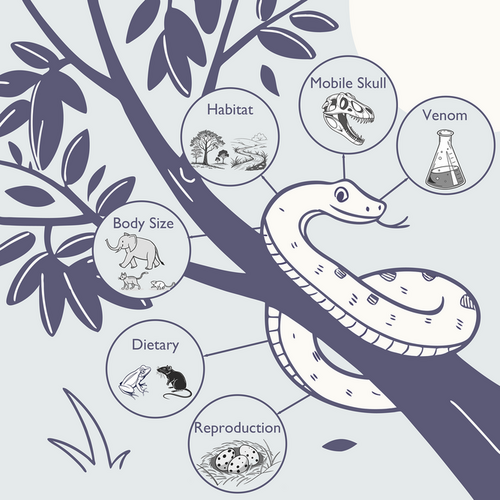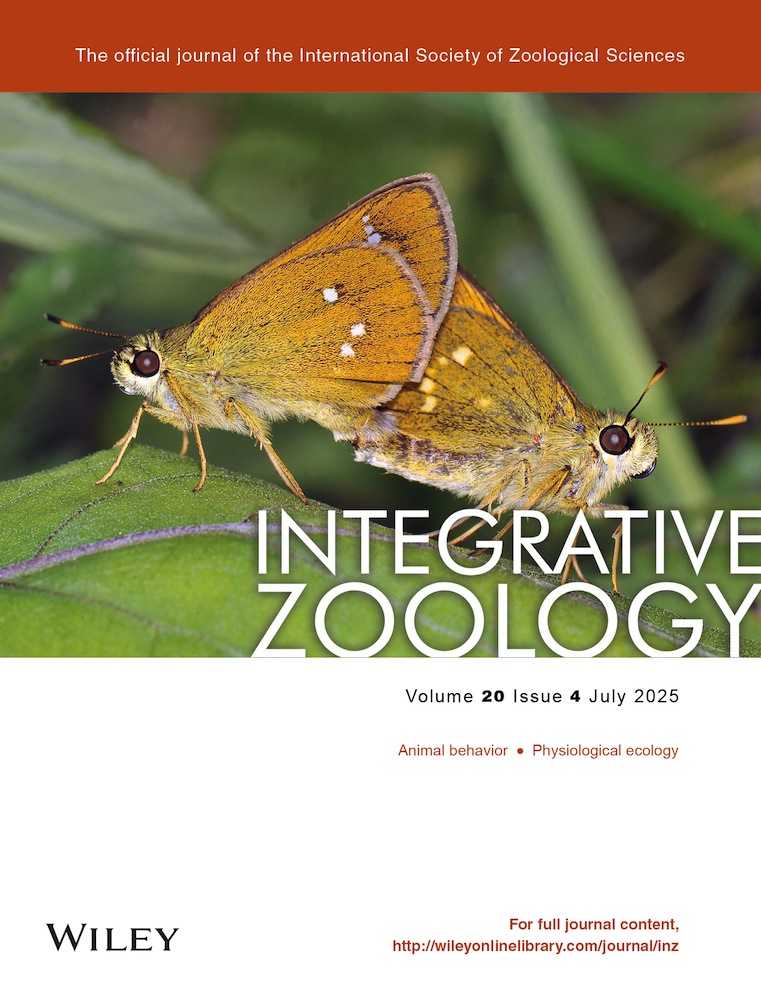From Venom to Viviparity: Functional Traits of Snakes and Their Role in Ecosystem Stability
Funding: This work was supported by the National Key Research and Development Program of China (2023YFF1304902) and the National Science Foundation of China (32470543).
Graphical Abstract
Snakes possess unique functional traits—such as venom system, reproductive mode, and dietary specialization—that regulate ecosystems and enhance resilience. This commentary highlights their role in maintaining food web stability and emphasizes the need to integrate snake functional diversity into conservation strategies under global change.
The Year of the Snake, a recurring year in the traditional Chinese zodiac cycle, provides an opportunity to reconsider the ecological importance of snakes, a group historically underprioritized in conservation research despite their important functional roles. Snakes play crucial roles in regulating prey populations, particularly small mammals, amphibians, lizards, and insects (Healy et al. 2019; Wu et al. 2023). Their predatory activities can suppress prey abundance, influence prey behavior, facilitate trophic energy flow, and maintain ecosystem balance (Willson and Winne 2016). Snakes are a highly distinctive group of animals, marked by a range of unique traits in their morphology, behavior, and evolutionary history (Peng et al. 2023; Title et al. 2024). They provide a compelling model for trait-based ecological research, offering a “Functional Toolbox”-shaped by a series of evolutionary innovations. Their venom systems exhibit remarkable interspecific and intraspecific diversity, with toxin compositions precisely adapted to specific prey types, enabling rapid prey capture and often indicating dietary specialization (Moniz et al. 2022; van Thiel et al. 2022). Likewise, their reproductive diversity including oviparity, viviparity, and ovoviviparity, allows snakes to thrive across a wide range of climatic conditions and habitats, enhancing their resilience to environmental variability (Feldman et al. 2015). In addition to venom and reproductive traits, other functional adaptations such as highly mobile skulls and infrared-sensing have likely contributed significantly to snake diversification (Peng et al. 2023; Title et al. 2024). These traits make snakes an excellent model for studying how functional adaptations mediate ecological processes across environmental gradients.
Deepening our understanding of snake ecology requires comprehensive trait–function databases to systematically document critical ecological, physiological, and behavioral traits, including venom properties, reproductive strategies, body size, dietary diversity, and habitat preferences. Such databases are important for advancing our understanding of biological diversity and its spatial and temporal dynamics (Mammola et al. 2021). Significant progress has been made with the publication of the ReptTraits dataset, which compiles 40 morphological, physiological, behavioral, and life-history traits across 12 060 reptile species (Oskyrko et al. 2024). However, further enhancement is needed, particularly in quantifying venom-specific attributes such as toxicity levels and venom yields, which are critical for understanding predatory efficiency and ecological interactions. Integrating existing venom-related datasets from clinical toxicology data could enhance the applicability of these databases for ecological network modeling. These integrative efforts will strengthen our ability to predict and manage snake-related ecological processes.
Although substantial progress has been made in assembling functional trait datasets, further efforts are necessary to deepen our understanding of how these traits influence ecological and evolutionary processes in two aspects. The first question focuses on the role of venom in shaping ecological interactions. Venom significantly enhances snakes’ predatory efficiency, enabling them to subdue prey larger than themselves, thereby expanding dietary niches and contributing to their ecological success (van Thiel et al. 2022). Despite its importance, the broader ecological consequences of venom, particularly its influence on food web dynamics, trophic interactions, and ecosystem complexity, remain largely unexplored. Variations in venom composition and strength across snake species can significantly influence prey populations, predator–prey relationships, and even lower trophic levels (van Thiel et al. 2022). Furthermore, venom's role in interspecific interactions, such as repelling competitors or predators, could reshape community structure, with cascading effects on ecosystem stability (Healy et al. 2019). To address these knowledge gaps, future research should integrate venom trait data into ecological network models, utilizing existing clinical toxicology datasets to quantify venom's ecological impacts across diverse ecosystems. Such studies will clarify how venom contributes to ecosystem resilience and provide strategies to mitigate the effects of environmental change on snake-mediated ecological processes.
The second question focuses on the ecological and evolutionary drivers of reproductive strategy diversity, particularly the factors influencing viviparity versus oviparity. Previous studies have proposed an association between colder climates and viviparity, suggesting that environmental pressures, such as increased egg mortality in harsh conditions, favor embryo retention in utero (Richard 2014). Large-scale phylogenetic analyses reinforce this pattern, demonstrating that viviparity is correlated with higher diversification rates and is more prevalent in colder regions globally except Africa (Feldman et al. 2015; Pyron and Burbrink 2014). Molecular studies on lizards provide further insights, revealing that changes in gene expression in the maternal oviduct during reproductive development, rather than sequence-level convergence, primarily drive the oviparity-to-viviparity transition (Gao et al. 2019). These findings suggest that reversals from viviparity to oviparity may be more flexible than previously assumed. However, there are some exceptions that challenge the cold-climate hypothesis: viviparous Trimeresurus species are distributed in the relatively warm regions of southern China, while ovoviviparous Gloydius species inhabit colder northern climates. These discrepancies reveal important gaps in our understanding of the ecological benefits of viviparity and the molecular mechanisms driving its evolution, highlighting the need for further investigation to clarify these complex patterns.
Climate change is significantly altering the ecological roles and vulnerabilities of snakes by impacting their functional traits such as venom potency, body size, and reproductive strategies (Brown and Shine 2007). Broad-scale climate proxies, such as the El Niño-Southern Oscillation (ENSO) and North Atlantic Oscillation (NAO), alter temperature, precipitation, and the geographic synchrony of population cycles, significantly influencing predator–prey dynamics (Wan et al. 2022). Climate warming could cause range shifts and compress habitats, disrupting established trophic relationships, while climate-driven selection may favor certain traits, such as viviparity in colder regions, but disadvantage others, potentially leading to simplified ecological networks. For example, the decline of snake populations under climate stress could weaken their ecological buffering capacity, resulting in increased synchrony of prey outbreaks across regions, which undermines ecosystem resilience. The selective loss of functionally critical snakes, such as large-bodied predators, could trigger trophic cascades, further destabilizing ecosystems. These climate-induced changes highlight the importance of understanding how snake traits mediate ecological responses to environmental pressures.
Addressing these challenges requires prioritizing keystone snake species whose functional traits are important for ecosystem health. Measures of snake functional diversity should be integrated into ecosystem resilience assessments and habitat restoration initiatives to address the risks posed by the loss of trait diversity, which threatens ecological stability under global change. While trait-based approaches are more common in plant research, the TRY database contains almost three million trait entries for 69 001 plant species (Kattge et al. 2020), but their application to vertebrate predators like snakes remains scarce. Broadening their application will deepen our understanding of snake ecology and provide insights into biodiversity and ecosystem function in a rapidly changing world.
In conclusion, snakes are a highly diverse group with distinctive combinations of traits, including venom composition, reproductive strategies, and dietary specialization, which play important roles in ecological processes and ecosystem stability. While novel tools like the ReptTraits dataset mark significant progress, key aspects of snake functional ecology, particularly venom and viviparity, remain underexplored. As climate change reshapes species distributions and ecological interactions, incorporating snake functional diversity into trait-based research and conservation strategies will be important for preserving biodiversity and enhancing ecosystem resilience.
Acknowledgments
We are grateful to Prof. Guangping Huang and Huizhong Fan for their valuable comments on this paper. This work was supported by the National Key Research and Development Program of China (2023YFF1304902) and the National Science Foundation of China (32470543).





